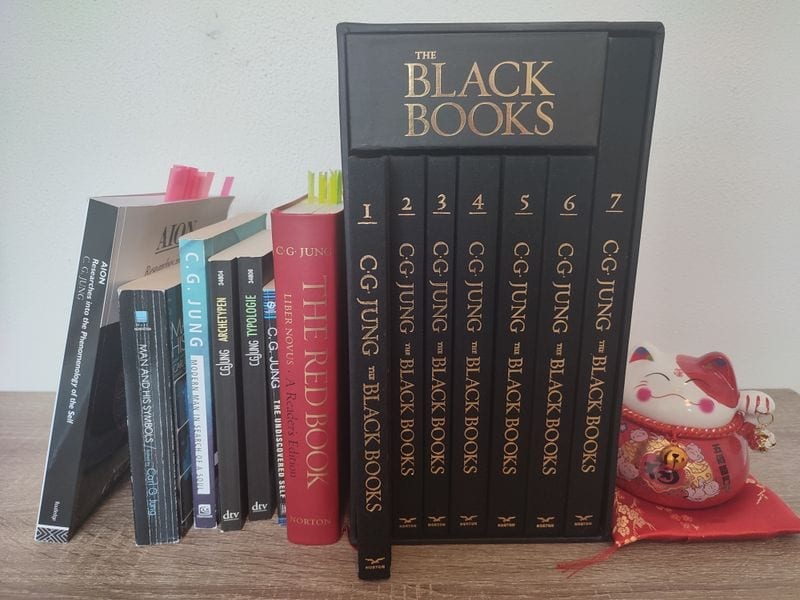Table of Contents
Introduction
Carl Jung’s Black Books consist of 7 Volumes written by Jung between 1913 and 1932. They were not available to the general public until the end of 2020, when Sonu Shamdasani published an edited edition, including an introduction to the Black Books. As Sonu Shamdasani indicated at the back of the book-set, they were the most important unpublished work written by Carl Jung.
In this series of 7 articles, I will attempt to analyse, summarize, and discuss each volume separately. Since the books are still rather expensive, I thought it would be interesting to discuss its contents on this blog, so that, among other things, everyone can hopefully understand what they are all about, without having to purchase the books, or read to the entire 7 volumes. I will make a full review of the Black Books as well, after finishing all the volumes.
Personally, I have decided to buy the Black Books, because I was thoroughly intrigued by the Red Book. According to the editor, Sonu Shamdasani, only material that was written in the Black Books between 1913 and 1916 was incorporated in the Red Book. In this sense, it is possible to consider the Black Books as an extension of the Red Book. I have read the Red Book multiple times and am eager to continue this journey with Carl Jung.

Introduction to Volume 1
The first of the seven volumes of the Black Books consist of an extensive introduction written by the editor Sonu Shamdasani. The original first volume was written by Carl Jung during his childhood and is considered to be of less interest to us readers. As a result, the editor decided to replace this first volume with an introduction to the Black Books, therefore the remaining volumes could maintain their original numbering.
In this introduction, Sonu Shamdasani, elaborated on the events in Carl Jung’s life that led up to the creation of the Black Books, and the writing process of the Black Books themselves.
Prior to writing the Black Books, before World War I, Carl Jung had several visions of Europe being flooded by a river of blood. Carl Jung believed that he might be going insane, however, when a war did indeed break out, and Europe was flooded by a river of blood, he believed that his visions might have a different origin.
As Sonu Shamdasani indicated as well, in the period leading up to the outbreak of World War I, images like those presented to Carl Jung, were not uncommon in Europe: “In the years directly preceding the outbreak of war, apocalyptic imagery was widespread in European arts and literature.” (p.19) As a result, Carl Jung considered the possibility that his images had their origin in a collective unconscious: “In Jung’s view, his undertaking pertained not just to himself but to others as well: he had come to view his fantasies as stemming from a general mythopoeic layer of the psyche, which he named the collective unconscious.” (p.12)
Individuation
Carl Jung stressed how important it was for an individual to become aware of the collective unconscious, as well as one’s private unconscious forces. Carl Jung called this process individuation. I have written an extensive article on this process which you can find here: Integrating the Unconscious.
For now, it is important to note that Carl Jung believed that this process of individuation, undertaken on the individual level, could have extremely important consequences for entire nations. The war revealed to man that he is still brutal, even if he considers himself civilized. Even though the war had been fought between nations, it is, according to Carl Jung, the reality that the nature of the individual relates to the nature of the nation and vice versa: “The psychology of the individual corresponds to the psychology of the nation. What the nation does is done also by each individual, and so long as the individual does it, the nation also does it.” (The Psychology of the Unconscious Processes: An Overview of Modern Theory and Method of Analytical Psychology, p.4)
The only way that the nation can change, therefore, according to Carl Jung, is trough changes within the psyche of the individual: “Only the change in the attitude of the individual is the beginning of the change in the psychology of the nation. The great problems of humanity will never be solved through general laws, but always only through the renewal of the attitude of the individual.” (Ibid)
In the introduction to the Black Books, Sonu Shamdasani observed that Carl Jung argued that, after the French Revolution, people became more sceptical towards religions and other ideas that were considered irrational. As a result, Carl Jung believed that these ‘irrational’ ideas had remained repressed for too long, and eventual this repression culminated in the outbreak of World War I: “It was thus a historical necessity to acknowledge the irrational as a psychological factor. The acceptance of the irrational forms one of the central undertakings in the Black Books.” (p.58)
The Importance of Symbols
In this regard, Carl Jung believed that symbols are of extreme importance. These symbols serve as a bridge to the unconscious world, and therefore creates room for the irrational. Sonu Shamdasani noted that: “Symbols, he [Carl Jung] argued, stemmed from the unconscious, and the creation of symbols was the most important function of the unconscious. While the compensatory function of the unconscious was always present, the symbol-creating function was only present when we were willing to recognize it.” (p.73)
The Red Book, as well as the Black Books were, as observed by Sonu Shamdasani, an attempt my Carl Jung to explore this power of the symbol-creating function, which is present within every individual.
As I have mentioned in previous articles, Carl Jung argued that there exist two dimensions in this world, the spirit of the times and the spirit of the depths. According to Sonu Shamdasani, Carl Jung saw it as his task to translate what he learned from the exploration of the spirit of the depths, into the language of the spirit of the times.
The Ultimate Goal
Through the process of writing the Black Books and the self-exploration that was necessary to do so, Carl Jung came to realize that the goal of this process was the development of the self: “The realization was that the self was the goal of the process of individuation. Progression was not linear but involved a circumambulation of the self.” (p.99)
As I mentioned in a previous post as well, Carl Jung called the entirety of an individual’s personality, the combination of the the conscious personality (the ego) and the unconscious personality, the self. In order to reach this goal of the development of the ‘mature’ self, Carl Jung believed that every individual must go through several stages of exploration. One had to explore the personal unconscious, integrate one’s anima or animus, and explore the collective unconscious.
In order to integrate these aspects of the self, and thereby develop a mature self, Carl Jung argued that one might engage in inner dialogues through, for example, active imagination: “Everyone, he [Carl Jung] claimed, had this ability to hold dialogues with him- or herself. Active imagination would thus be one form of inner dialogue, a type of dramatized thinking.” (p.101) This would result in the establishment of a form of communication between the conscious and unconscious forces.
The exploration of the unconscious would result in a mature self, this in turn was, according to Carl Jung, the ultimate goal of life, because it is the fullest expression of the unique individual:
“The self is also the goal of life, because it is the most complete expression of that fateful combination we call individuality […] With the experiencing of the self as something irrational, as an indefinable being to which the I is neither opposed nor subjected, but in a relation of dependence, and around which it revolves, very much as the earth revolves about the sun – then the goal of individuation has been reached.” (p.314)
What we can Learn from the Black Books
At the end of this first introductory volume, Sonu Shamdasani shared with us what he believed we could learn from the Black Books. He indicated that the Black Books offer a unique insight in the development of the thoughts and ideas of one of the most important psychologists to have ever lived.
Carl Jung, by writing the Black Books, attempted to connect with his own self, but also illustrated how every individual could do so as well: “As a document humain and psychological record, the Black Books chart Jung’s attempt to resolve the twentieth-century crisis of meaning in his own person, and distill from this a means through psychotherapy for others to do likewise.” (p.122)
The Black Books, as well as the Red Book, form, in the words of Sonu Shamdasani,
“The core of analytical psychology, and enable its historical genesis to be studies from its inception.” (Ibid)
Friedrich Nietzsche, through his character Zarathustra announced the death of God. Carl Jung, though his writing of the Red Book and the Black Books, portrayed the rebirth of God within the soul: “Whereas Zarathustra proclaims the death of God, Liver Novus [the Red Book] depicts the rebirth of God in the soul.” (p.40)

